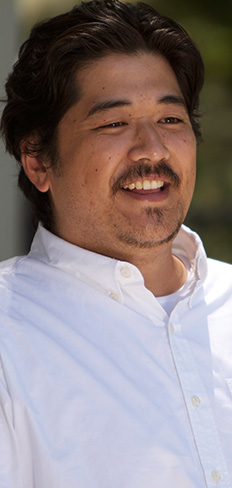Visitors to Art Center’s homepage may have found themselves wondering if that Brady Bunch-like grid of student selfies splayed out on Art Center’s homepage was some kind of post-modern meditation on ’70′s pop culture. And they’d be wrong. The real explanation — a refreshed batch of student profiles — is a lot like Art Center itself: A practical solution to a real world need whose outcome is a lot more interesting than anyone might have expected going into the project.
Over the next few weeks, we’ll be rolling out a series of deeper dives into the creative lives of those profile subjects, with highlights from the body of work they’ve produced at Art Center. We’re kicking off the series with this look at Product Designer Alex Cabunoc’s truly impressive array of innovative social impact designs aimed at improving the lives of inhabitants rural communities in the developing world. For the project featured in the above video, Cabunoc teamed up with fellow student Ji A You to create the GiraDora foot-powered washing machine for a Designmatters challenge to alleviate the water shortage in Lima, Peru. The product he produced has vast potential to improve the health and quality of life of women in water-poor communities throughout the developing world. In the below Q&A, Cabunoc provides some personal context to his Art Center journey.
What was your background prior to Art Center?
Alex Cabunoc: As an older student, my background before coming to Art Center is pretty varied. I have a previous bachelors degree in Fine Arts focusing on Metal Sculpture from U.C. Santa Cruz. After graduating from Santa Cruz, I spent time in New York City and then moved to Tokyo, Japan to teach English via the J.E.T. Programme. When I returned to Los Angeles after a few years I eventually ended up working in the Marketing department of a large financial institution. I worked my way up from a temp to Sr. Graphic Designer in about 5 years time. However, as rewarding as that job was, I realized it just wasn’t the right fit and began taking night classes at Art Center to prep my entrance portfolio.
What advice would you give to prospective Art Center students?
Alex Cabunoc: Art Center is not your typical college experience. I would liken it more to a whetstone and you are the dull blade. Each day you will be dragged across its edge. It will not be fun a lot of the time. What you eat, the amount you sleep will not be ideal to put it lightly. You’ll often have to sacrifice things like weekends, and hanging out with friends, birthdays and holidays. But in the end, you will be that much sharper and that much more honed in your craft and ability. Really consider this beforehand and if it doesn’t sound like something you really want, look elsewhere.
What are your most reliable and/or unlikely sources of inspiration?
Alex Cabunoc: Among my most reliable and equally unlikely sources of inspiration are things that frustrate me or give me problems. As a product designer, I believe that we are problem-solvers at the most fundamental level. We strive to create efficiency, whether that is in form or in function. So just by living and experiencing minor annoyances to all-out challenges has provided me with a wealth of inspiration to draw from.
What resources at Art Center have been most valuable to your growth as an artist/designer?
Alex Cabunoc: Without a doubt, one of the best resources here at Art Center are the personnel. While it’s true that we have great facilities with high-end and expensive devices. All of that would mean nothing without the people behind them. I have had such an opportunity to learn from and grow under the tutelage of some of the most talented people I’ve ever known. They bring with them skills that have been honed from years of real world experiences and are all so willing to share their knowledge.
How has the College’s commitment to social impact design impacted the direction of your work?
Alex Cabunoc: When I first began at Art Center I had no idea what I wanted to do when I graduated. I vaguely thought toy design would be a good field for me to enter. But about halfway through my studies here, I participated in DesignMatters Safe Agua Peru and that has completely changed the trajectory of my educational career here at Art Center. From that class, I experienced what social impact design was like. I studied in the field. I interacted with actual end-users. I was forced to consider things like ethnography, anthropometrics, culture, class, socio-economic standing, business, distribution and market. The product of that class for my group was GiraDora — A human-powered washer and spin-dryer to increase the efficiency and improve the experience of hand-washing clothes. Now, almost two years later, I am continuing to work on this project to hopefully bring it to market and eventually achieve that goal that we were tasked with when we first entered the class — “Impact the lives of 1 million people.” At the time, that goal seemed so far out of reach that it was just lip service. But with each small hurdle that is overcome, that goal comes a little closer to fruition. I am not sure if GiraDora will ever be able to reach it, but the experiences and lessons that I’ve learned along the way have already galvanized me into the type of designer that sees the importance and value of social impact design.









